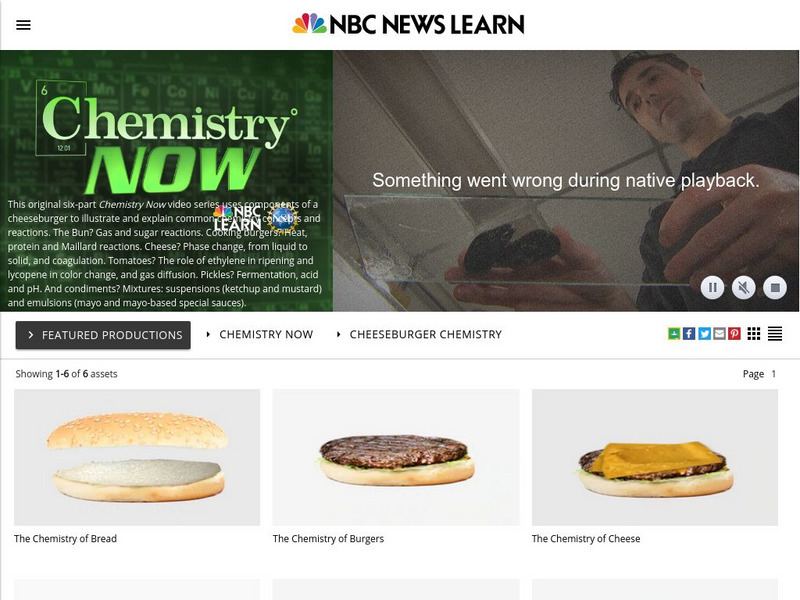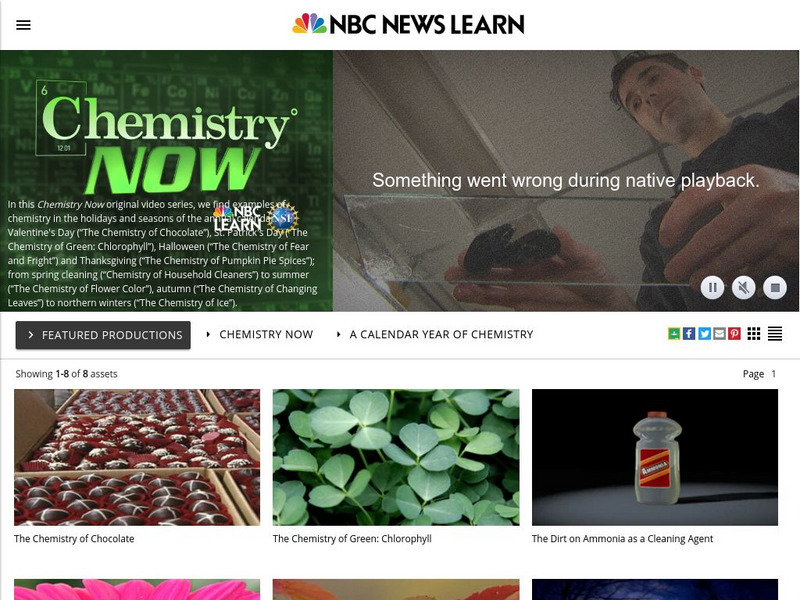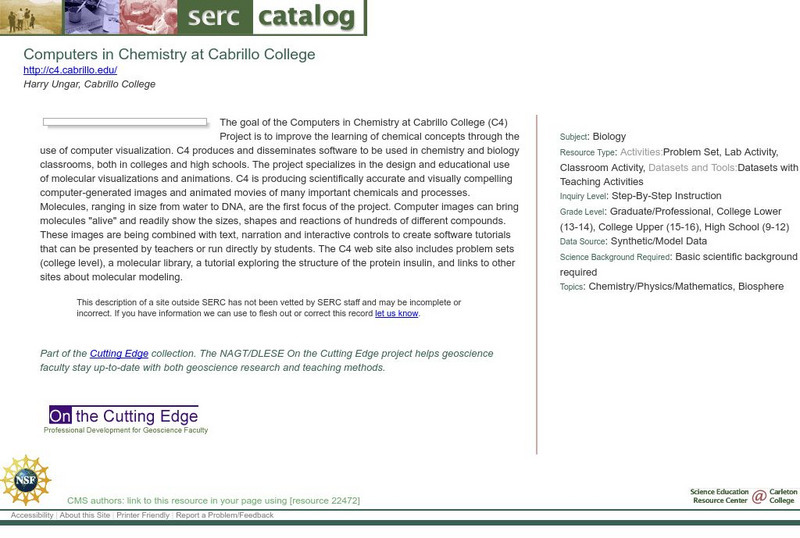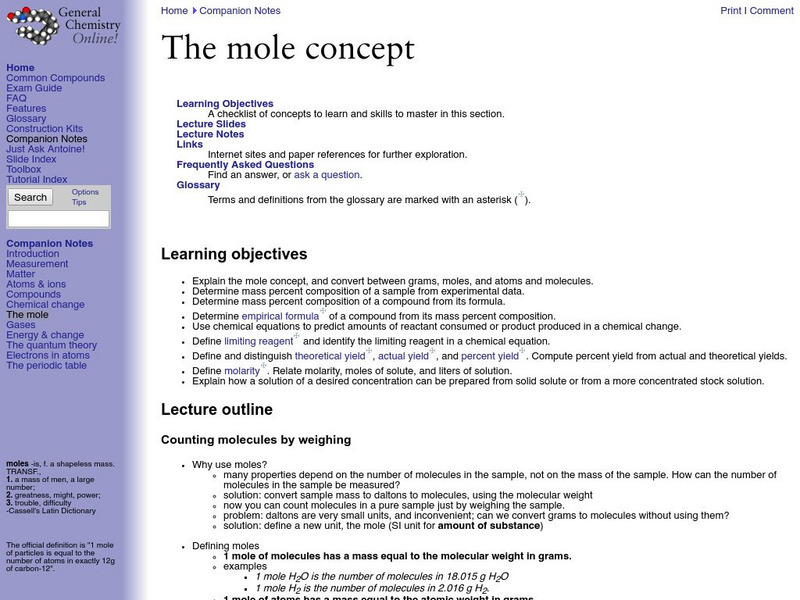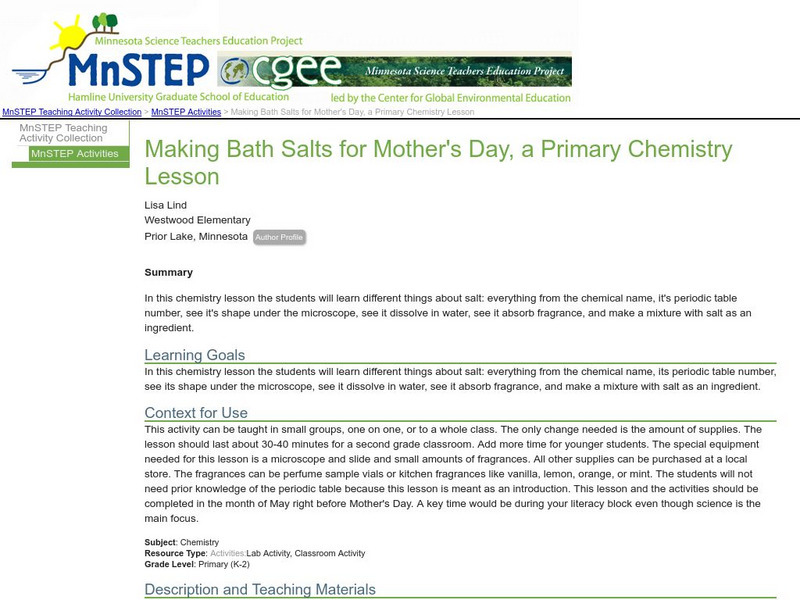NBC
Nbc Learn: Cheeseburger Chemistry
This original six-part Chemistry Now video series uses components of a cheeseburger to illustrate and explain common chemistry concepts and reactions. Videos include the science of the bun, the burger, cheese, tomatoes, pickles and...
NBC
Nbc Learn: A Calendar Year of Chemistry
In this Chemistry Now original video series, we find examples of chemistry in the holidays and seasons of the annual calendar. Take a look at Valentine's Day, St. Patrick's Day, Halloween and Thanksgiving. Other topics include the...
American Chemical Society
Middle School Chemistry: Chapter 1: Solids, Liquids, and Gases
Five exemplary chemistry lessons about the three states of matter complete with handouts and animations.
American Chemical Society
Middle School Chemistry: Chapter 2: Changes of State
Five chemistry lessons about phase changes between the states of mattter complete with handouts and animations.
American Chemical Society
Middle School Chemistry: Chapter 3: Density
Six interactive chemistry lessons about density complete with handouts and animations.
American Chemical Society
Middle School Chemistry: Chapter 5: The Water Molecule and Dissolving
Nine exemplary chemistry lessons about the water molecule and dissolving complete with handouts and animations.
American Chemical Society
Middle School Chemistry: Chapter 6: Chemical Change
Twelve interactive chemistry lessons about chemical changes complete with handouts and animations.
American Chemical Society
Middle School Chemistry: Chapter 4: The Periodic Table and Bonding
Six middle school chemistry lessons about the periodic table and bonding complete with handouts and animations.
Utah STEM Foundation
Utah Stem Action Center: Marie Curie and Chemistry
Lesson teaches about Marie Curie and Chemistry. Lab activities include making slime, elephant toothpaste, and snow, and also a balloon rise.
Science Education Resource Center at Carleton College
Serc: Computers in Chemistry at Cabrillo College
The Computers in Chemistry at Cabrillo College project creates visually compelling and effective educational chemistry software for both students and instructors. Includes molecular models, student exercises, tutorials, and posters that...
Science Education Resource Center at Carleton College
Serc: Intro to Chemistry Tools and Vocabulary Through Word Walls and Centers
In this activity, students will be exposed to introductory words along with names and pictures of tools in the chemistry classroom. They will be exposed to the vocabulary by looking at and reciting words from a slide show and then as a...
Science Education Resource Center at Carleton College
Serc: Coupled Plasma Mass Spectrometer to Teach About Water Chemistry
In this lesson students will use data acquired with an ICP-MS to teach them about water chemistry at a variety of levels.
Frostburg State University
General Chemistry Online: Faq the Mole Concept
This FAQ site over general chemistry concepts presents the question: "Why are moles used?" It explains what moles are and how they can be used to count molecules and how grams can be turned into moles.
Science Education Resource Center at Carleton College
Serc: Making Bath Salts for Mother's Day, a Primary Chemistry Lesson
What do you know about salt? In this chemistry lesson, students will learn different things about salt: the chemical name, it's periodic table number, it's shape under the microscope, how it dissolves in water, and how to make a mixture...
Science Education Resource Center at Carleton College
Serc: Introductory Concepts in Soil Chemistry
In this introductory lab activity, students will collect data that will graphically illustrate the relationship between mass and volume in determining the density in chemistry. Based on density, students will seek to determine a...
Other
Science Alive: What Is Organic Chemistry?
This reading/lesson plan introduces students to the concept of organic chemistry.
National Association of Geoscience Teachers
Nagt: The Chemistry of Sand: Not All Beaches Are Created Equal
A laboratory activity where students investigate the chemistry of sand based on whether and how much it reacts with hydrogen chloride. They then make predictions and observe what happens when they do the same with various shell pieces.
American Chemical Society
Middle School Chemistry: Lesson Plans: Temperature Changes in Dissolving
Media-rich lesson in which young scholars discover that it takes energy to break bonds, and that energy is released when bonds are formed during the process of dissolving. They also determine whether dissolving is either exothermic or...
American Chemical Society
Middle School Chemistry: Density: Sink and Float for Solids
Students determine whether an object will sink or float by comparing its density to the density of water.
American Chemical Society
Middle School Chemistry: P H and Color Change
Students see a demonstration of a color change using universal pH indicator and then change the concentrations of an acid and a base using a universal indicator to test the pH of the resulting solutions. Through an animation, they see...
American Chemical Society
Middle School Chemistry: Neutralizing Acids and Bases
Students will use citric acid and sodium carbonate solutions to see that adding a base to an acidic solution makes the solution less acidic. Students will then use a base to help them identify which of two acidic solutions is more...
American Chemical Society
Middle School Chemistry: Carbon Dioxide Can Make a Solution Acidic
Students explain that carbon dioxide from any source reacts chemically with water to form carbonic acid. They will also be able to use the color changes of universal indicator to monitor the changing pH of a solution during a chemical...
Other
Cambridge University: Atmospheric Chemistry Research Group: The Ozone Hole Tour
This resource gives information about the ozone hole over Antarctica. There are movies, virtual reality models, explanations and photographs. QuickTime plug-in optional.
American Chemical Society
Middle School Chemistry: Lesson Plans: What Is a Chemical Reaction?
After observing a demonstration of a chemical reaction between a burning candle and the oxygen in the air, students use atom model cut-outs to model the reaction and see that all the atoms in the reactants show up in the products.
Other popular searches
- Organic Chemistry
- Chemistry Chemical Reactions
- Chemistry Periodic Table
- Chemistry Equations
- Chemistry of Life
- History of Chemistry
- Chemistry Lesson Plans
- Organic Chemistry Projects
- Food Chemistry
- Chemistry Current Events
- Chemistry of Soap
- Water Chemistry
